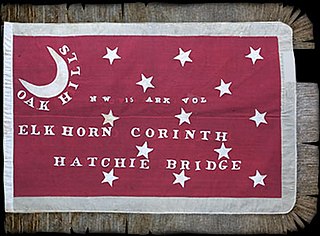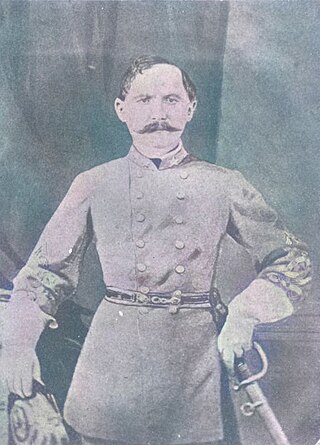
James Dearing was a Confederate States Army officer during the American Civil War who served in the artillery and cavalry. Dearing entered West Point in 1858 and resigned on April 22, 1861, when Virginia seceded from the Union. Dearing was mortally wounded at the Battle of High Bridge during the Appomattox Campaign of 1865, making him one of the last officers to die in the war. Despite serving as a commander of a cavalry brigade and using the grade of brigadier general after he was nominated to that grade by Confederate President Jefferson Davis, Dearing did not officially achieve the grade of brigadier general because the Confederate Senate did not approve his nomination. His actual permanent grade was colonel.

The Battle of Droop Mountain occurred in Pocahontas County, West Virginia, on November 6, 1863, during the American Civil War. A Union brigade commanded by Brigadier General William W. Averell defeated a smaller Confederate force commanded by Brigadier General John Echols and Colonel William L. "Mudwall" Jackson. Confederate forces were driven from their breastworks on Droop Mountain, losing weapons and equipment. They escaped southward through Lewisburg, West Virginia; hours before a second Union force commanded by Brigadier General Alfred N. Duffié occupied the town.
1st Arkansas Mounted Rifles (1861–1865) was a Confederate States Army cavalry regiment during the American Civil War. The unit was formed as a mounted infantry regiment, but was dismounted in the spring of 1862 and remained dismounted for the remainder of the war. The unit participated in the earliest battles in the western theater at Wilson's Creek and surrendered with the remnants of the Army of Tennessee in North Carolina in April 1865.

The Cherokee in the American Civil War were active in the Trans-Mississippi and Western Theaters. In the east, Confederate Cherokees led by William Holland Thomas hindered Union forces trying to use the Appalachian mountain passes of western North Carolina and eastern Tennessee. Out west, Confederate Cherokee Stand Watie led primarily Native Confederate forces in the Indian Territory, in what is now the state of Oklahoma. The Cherokee partnered with the Confederacy in order to get funds, as well as ultimately full recognition as a sovereign, independent state.

The Choctaw in the American Civil War participated in two major arenas—the Trans-Mississippi and Western Theaters. The Trans-Mississippi had the Choctaw Nation. The Western had the Mississippi Choctaw. The Choctaw Nation had been mostly removed west prior to the War, but the Mississippi Choctaw had remained in the east. Both the Choctaw Nation and the Mississippi Choctaw would ultimately side with the Confederate States of America.

The units of the Arkansas Militia in the Civil War to which the current Arkansas National Guard has a connection include the Arkansas State Militia, Home Guard, and State Troop regiments raised by the State of Arkansas. Like most of the United States, Arkansas had an organized militia system before the American Civil War. State law required military service of most male inhabitants of a certain age. Following the War with Mexico, the Arkansas militia experienced a decline, but as sectional frictions between the north and south began to build in the late 1850s the militia experienced a revival. By 1860 the state's militia consisted of 62 regiments divided into eight brigades, which comprised an eastern division and a western division. New regiments were added as the militia organization developed. Additionally, many counties and cities raised uniformed volunteer companies, which drilled more often and were better equipped than the un-uniformed militia. These volunteer companies were instrumental in the seizure of federal installations at Little Rock and Fort Smith, beginning in February 1861.
The Jeff. Davis Legion was a cavalry regiment of the Confederate States Army. Made up of companies from Mississippi, Alabama, and Georgia; it fought primarily in the Eastern Theater of the American Civil War. In 1865, it was reassigned to the Army of Tennessee, surrendering at Greensboro, N.C.

The 15th (Northwest) Arkansas Infantry Regiment (1861–1865) was a Confederate Army infantry regiment during the American Civil War. The unit was originally formed as the 3rd Arkansas Infantry Battalion. After receiving the required 10 companies, the unit was redesignated as the 21st (McRae's) Arkansas Infantry Regiment. Upon recognition that there was already a 21st Arkansas, the unit was again redesignated as the 15th Arkansas Infantry Regiment. This was the third Arkansas unit to bear the designation "15th Arkansas". The others are the 15th (Josey's) Arkansas Infantry Regiment and the 15th (Gee/Johnson) Arkansas Infantry Regiment. The unit saw action both west and east of the Mississippi, before serving in the Vicksburg campaign. The regiment was surrendered at Vicksburg in July 1863. After being paroled and exchanged, the regiment was consolidated with other depleted Arkansas regiments to form the 1st (Trans-Mississippi) Arkansas Consolidated Infantry Regiment.
The 7th Arkansas Infantry Battalion (1861–1862) was a Confederate Army infantry battalion during the American Civil War. The battalion, which was often referred to as Desha's Battalion, was eventually consolidated with the 9th Arkansas Infantry Battalion and the 8th Arkansas Infantry Regiment.
The following list is a bibliography of American Civil War Confederate military unit histories and are generally available through inter-library loan. More details on each book are available at WorldCat. For an overall national view, see Bibliography of the American Civil War. For histories of the Union, see Bibliography of American Civil War Union military unit histories. For a guide to web sources see: Carter, Alice E.; Jensen, Richard. The Civil War on the Web: A Guide to the Very Best Sites—Completely Revised and Updated (2003).
The 1st Arkansas Cavalry Battalion (Stirman's) (1864–1865) was a Confederate Army cavalry battalion during the American Civil War. The unit was also known as Brooks 1st Arkansas Cavalry Battalion, Stirman's, 1st Arkansas Cavalry Battalion, Stirman's Sharpshooter Regiment, 1st Regiment Arkansas Sharpshooters, and finally simply as Stirman's Arkansas Cavalry Regiment.

The 1st Missouri Cavalry Regiment was a cavalry regiment that served in the Confederate States Army during the American Civil War.

The 9th Texas Cavalry Regiment was a unit of mounted volunteers that fought in the Confederate States Army during the American Civil War. The regiment fought at Round Mountain and Bird Creek (Chusto-Talasah) in 1861, Pea Ridge, Siege of Corinth, Second Corinth, Hatchie's Bridge and the Holly Springs Raid in 1862, and in the Atlanta campaign, Franklin, and Murfreesboro in 1864. The unit fought dismounted at Second Corinth and Hatchie's Bridge before being remounted as cavalry for the remainder of the war. The regiment surrendered to Federal forces on 4 May 1865 and its remaining personnel were paroled.

The 3rd Texas Cavalry Regiment or South Kansas-Texas Mounted Volunteers was a unit of mounted volunteers that fought in the Confederate States Army during the American Civil War. The regiment fought at Wilson's Creek and Chustenahlah in 1861, Pea Ridge, Corinth siege, Iuka, Second Corinth, and the Holly Springs Raid in 1862, Thompson's Station in 1863, and at Yazoo City, in the Atlanta campaign, and at Nashville in 1864. The regiment fought dismounted at Iuka and Second Corinth before being remounted for the rest of the war. The regiment surrendered to Federal forces in May 1865 and its remaining 207 men were paroled.

The 27th Texas Cavalry Regiment, at times also known as Whitfield's Legion or 1st Texas Legion or 4th Texas Cavalry Battalion, was a unit of mounted volunteers that fought in the Confederate States Army during the American Civil War. First organized as the 4th Texas Cavalry Battalion or Whitfield's Legion, the unit served dismounted at Pea Ridge and First Corinth. Additional companies from Texas were added and the unit was upgraded to the 27th Texas Cavalry Regiment or 1st Texas Legion later in 1862. Still dismounted, the unit fought at Iuka and Second Corinth. The regiment was remounted and fought at Holly Springs in 1862, Thompson's Station in 1863, and at Yazoo City, Atlanta, Franklin, and Third Murfreesboro in 1864. The regiment surrendered to Federal forces in May 1865 and its remaining soldiers were paroled.

The 6th Texas Cavalry Regiment was a unit of mounted volunteers that fought in the Confederate States Army during the American Civil War. The regiment fought at Chustenahlah in 1861. The following year the unit fought at Pea Ridge, First Corinth, Second Corinth, Hatchie's Bridge, and Holly Springs. The 6th Texas Cavalry participated in the fighting at Thompson's Station in 1863, the Atlanta campaign, and the Franklin–Nashville Campaign in 1864. The regiment formally surrendered to Union forces in May 1865 and its remaining soldiers were paroled.

The 1st Texas Cavalry Regiment was a unit of mounted volunteers from Texas that fought in the Confederate States Army during the American Civil War. It was first organized as a 10-company regiment by Colonel Henry Eustace McCulloch in April 1861 and named the 1st Texas Mounted Rifles. In early May 1861, the regiment secured the surrender of the small Federal garrison of San Antonio. Except from a skirmish with Native Americans in November 1861, the regiment took part in no more actions. In April 1862, the unit was reduced to five companies and renamed the 8th Texas Cavalry Battalion. On 2 May 1862, William Overall Yager's 3rd Texas Cavalry Battalion was consolidated with the 8th Cavalry Battalion to form a new 1st Texas Cavalry Regiment under Colonel Augustus Buchel, a German soldier of fortune who emigrated to Texas in 1845. The regiment served on the Texas Gulf Coast in 1863 but later transferred to Louisiana. In 1864, it fought at Mansfield, Pleasant Hill, and Yellow Bayou in the Red River Campaign. After Buchel was killed at Pleasant Hill, Yager led the regiment for the rest of the war. The unit was included in the 2 June 1865 surrender.











